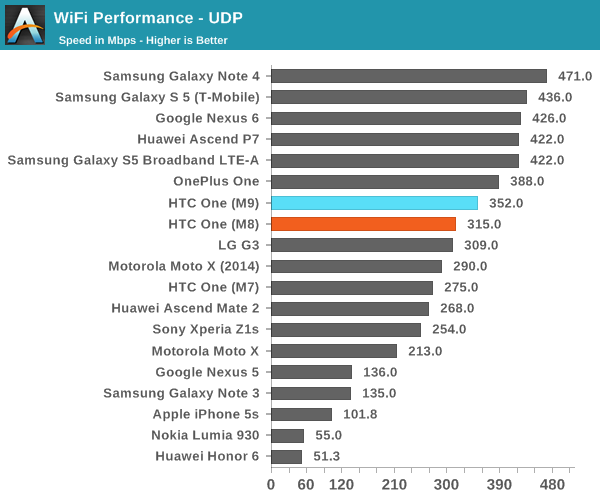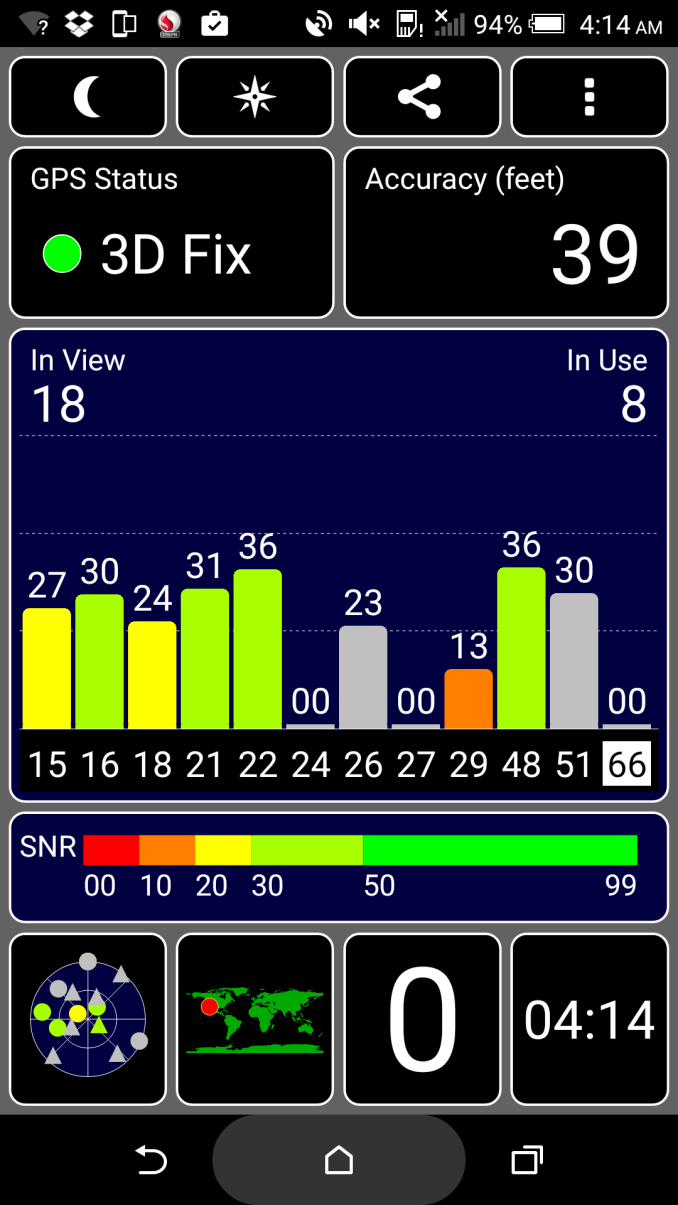The HTC One M9 Review: Part 2
by Joshua Ho on April 6, 2015 10:00 AM EST- Posted in
- Smartphones
- HTC
- Qualcomm
- Mobile
- Snapdragon 810
- One M9
WiFi Performance
Fundamentally, a smartphone is defined by its ability to connect to the internet. Although cellular data is important, WiFi performance is crucial for anyone on a limited data plan and in areas where cellular data is slow or nonexistent. To this end, HTC has outfitted the One M9 with Broadcom’s BCM4356 WiFi/BT combo chipset, which we’ve seen before in the Nexus 6. This chipset supports 2x2 802.11ac, but the One M9 only supports a maximum 433 Mbps physical link rate, which means that it’s only using a single spatial stream. I haven’t been able to find any information on the antenna configuration of the One M9, but it’s likely that HTC is only using a single antenna for WiFi on the One M9 which would make it similar to the One M7 and One M8 in that regard. In order to test how this configuration performs, we use IPerf on Android connected to a PC to see how rapidly the device can send UDP packets.

As one can see, there’s a reasonable performance uplift when compared to Qualcomm Atheros’ WCN3680 WiFi/BT combo chip, but it isn’t as big as moving to a 2x2 MIMO configuration. The lack of MIMO also has implications for WiFi range, but WiFi signals degrade quickly enough that this wouldn’t be a massive difference.
GNSS
As the One M9 uses a Qualcomm modem, it's a pretty safe bet that it also uses the modem for GNSS location services. In practice, this means that the One M9 locks on to satellites quickly any time it's possible to download assistance data to speed up GPS.
Without assistance data, the One M9 seems to have worse performance than expected, although weather conditions can always affect overall performance. Time to first lock took a minute and 42 seconds, and accuracy wasn't quite as high as one would hope, tending towards 30 foot accuracy rather than 10 foot accuracy. It's likely that local weather conditions were responsible for this issue, as subjectively it seemed that GPS performance was comparable to other phones tested at the same time.











127 Comments
View All Comments
jabber - Monday, April 6, 2015 - link
Yeah I rarely make calls on my phone. Why bother to spend 5 minutes chatting needlessly when maybe two short and quick text messages will do the same.Just have no use for small talk in day to day stuff. People only really call if they have to.
DanNeely - Monday, April 6, 2015 - link
The name smartphone is increasing a mis-nomer. The phone capability is a gateway feature; but the more the average person uses one, the more it ceases to be a phone, and instead becomes a hand computer that includes voice calls in the me-too feature checklist section. If almost all you're doing are voice calls and texting; any entry level phone will work as well as anything else on the market. It's the hand computer uses that differentiate the higher end models from each other.Dorek - Wednesday, April 8, 2015 - link
"But the camera is a gimmick."The camera is one of the most important features of a smartphone. Every smartphone can competently make and receive phone calls. Every $20 flip phone can do that!
maroon1 - Monday, April 6, 2015 - link
S6 has faster CPU and GPU, and far better display.ALso, does all android games run on 1440p on S6 ?! I mean just because the display is 1440p that does not means that the game will run on native resolution.
aenews - Tuesday, April 7, 2015 - link
Most games will not have a problem with 1440P and most higher-end games have options to adjust the resolution. I don't know if any games would by default output in 1080P (although it may not make a difference in some games).ToTTenTranz - Monday, April 6, 2015 - link
«There is also the issue of the “logo bar” bezel, but it’s physically impossible to get rid of this bezel due to engineering constraints.»I'm sorry Joshua but these are just HTC's claims and I call bollocks on that.
Check the M9's teardown at ifixit and you'll see the PCBs have lots of free space everywhere and is oddly shaped for no apparent reason at all. The difference for the iphones and Galaxy Ses is astounding, where everything is a lot more compact and neatly organized.
Nor is there any valid reason not to at least even out the black bar between top and bottom, making a symmetrical phone.
At this point, the "HTC black bar" is just a result of lazy industrial design choice and/or incompetent PCB design, IMO.
JoshHo - Monday, April 6, 2015 - link
I've discussed the issue with people outside of HTC, and independently verified HTC's claim by checking multiple device teardowns.Fundamentally, the display driver is a large chip that must be coplanar with the display. It's possible to hide the appearance of this display driver, but there is a minimum level of bezel necessary to enable an active matrix display.
Raniz - Monday, April 6, 2015 - link
Yet, somehow, Sony's bezel is significantly smaller.http://i-cdn.phonearena.com/images/articles/138100...
Connoisseur - Tuesday, April 7, 2015 - link
Looking at that pic, the Z3 totally has a bezel that's about the same size as HTC's. It just doesn't have a front firing speaker... Speaker height + Bezel Height = Complaints about HTC bezel size?TrojMacReady - Tuesday, April 7, 2015 - link
The Z3 has 2 front firing speakers, just like the HTC. They are even visible in the picture posted...